Seared Salmon Nigiri (Aburi Salmon) is one of the most popular nigiri sushi items at sushi train restaurants. The one with a sweet soy-based sauce brushed over the seared salmon is particularly popular. By searing it, the salmon becomes sweeter and more delicious. The faint aroma of charred flesh is also appetising.
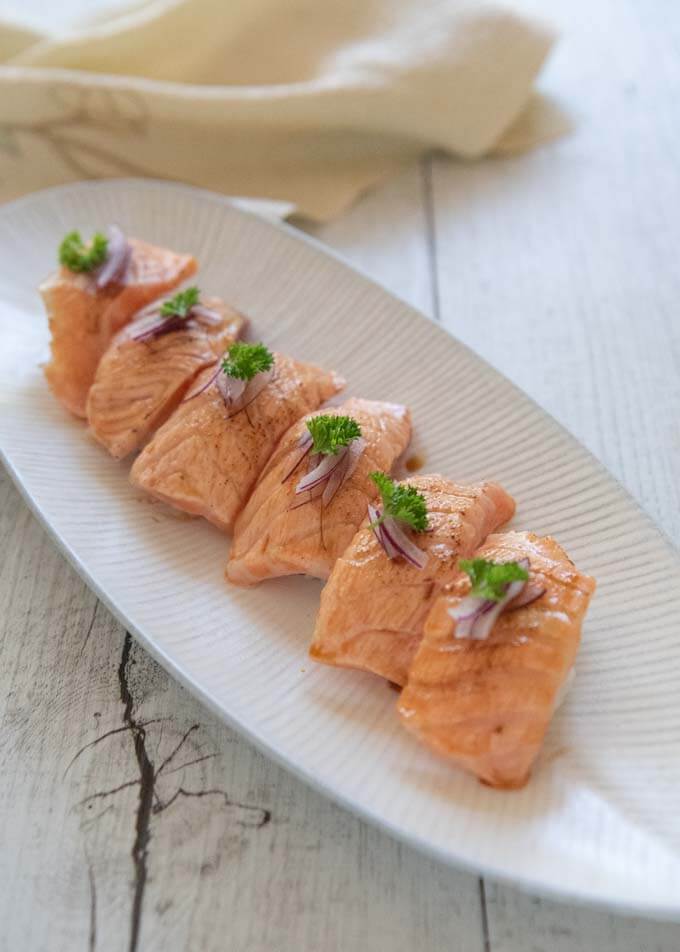
I had a request from a reader for the sweet sauce used on the Aburi Salmon that you get at sushi train restaurants. This was quite some time ago and today’s post is long overdue.
Seared Salmon Nigiri is probably one of the most popular raw fish nigiri sushi in Australia. Compared to the tuna nigiri, the salmon nigiri is much cheaper and the quality of the raw fish is good. The fatty flesh brings the best out of the raw salmon when it is seared.
Salmon Nigiri Sushi and Norway
Nigiri Sushi, which is called ‘nigirizushi’ (握り寿司) in Japan, originated in Tokyo in the Edo period when Tokyo was called Edo. To distinguish Edo-originated sushi from other types of sushi such as Chirashi Sushi, nigirizushi is also called ‘Edomaezushi’ (江戸前寿司), indicating the origin of the fish.
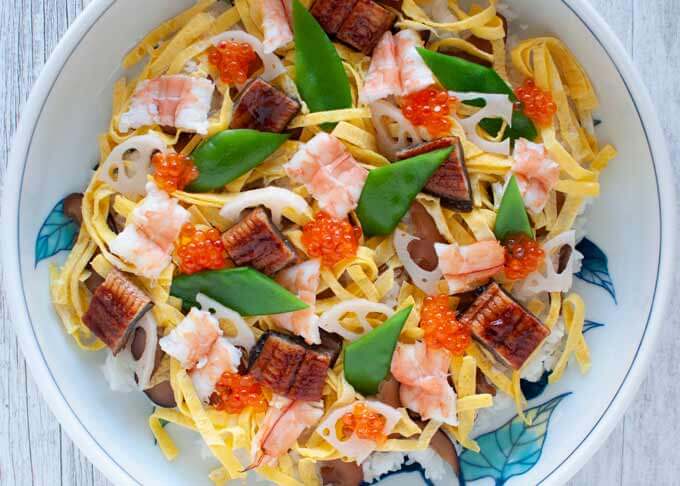
Chirashi Sushi is almost an opposite type of sushi to Nigiri Sushi.
The raw fish used for nigiri sushi were sourced from the fish caught in the Tokyo Bay area because there were no means of transporting fresh fish over a long distances at the time.
It was also known that the naturally grown salmon carried parasites, so people didn’t eat raw salmon. For this reason, salmon was not included in Nigiri Sushi until the late 20th century.
A quarter century before that, Norway began commercial salmon farming. In trying to market their farmed salmon, they targeted Japan. After overcoming many obstacles, Norway finally convinced a major Japanese seafood company to take up Norwegian salmon for raw consumption as a sushi item.
From then on, salmon sushi started gaining popularity. However, traditional Edomaezushi restaurants try to maintain hundreds of years of traditions and refuse to use salmon in their nigiri sushi. You will notice that expensive traditional sushi restaurants do not stock salmon.
The fact that popular salmon nigiri is often topped with mayonnaise is also a big issue for the traditional sushi chefs. They must be feeling it’s totally unorthodox.
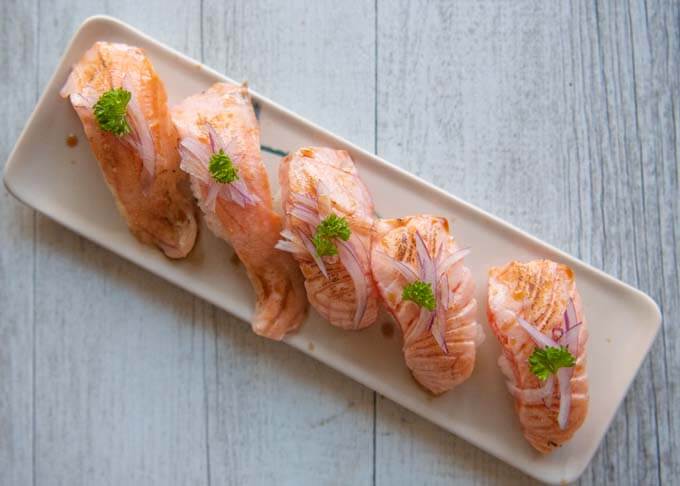
What’s in Seared Salmon Nigiri
There aren’t many ingredients in Seared Salmon Nigiri. Since today’s recipe is all about nigiri sushi, I decided to add sushi language in the ingredients list below.
- Vinegar rice made specifically for sushi – this is called ‘shari (シャリ)’ in the sushi world.
- Sashimi quality salmon fillet – slice into the size suitable for nigiri sushi.
- Tare (タレ) – thick, sweet soy-flavoured sauce, which consists of soy sauce, mirin and sugar.
- Tezu (手酢) – mixture of rice wine vinegar and water, used to wet your hands before handling the sushi rice.
- Garnish (optional) – thinly sliced red onion and sprig of parsley.
Do not buy sliced salmon sashimi from the shop unless it is sliced into the size suitable for nigiri sushi. Most sashimi sold at the shop is usually thicker and shorter in length, which is not sufficient to cover the rice.
Each nigiri sushi uses about 15g / 0.5oz of sushi rice, which is the standard size in Japan. The salmon piece should be a 3-5mm / ⅛-3⁄16″ thick rectangle of about 3cm x 8cm / 1¼” x 3⅛”, which weighs 15-18g /0.5-0.6oz.
Some sushi trains and sushi restaurants in Australia serve way too much rice with very thin and small pieces of raw fish (that’s a rip off!)
Other than the above ingredients, you will need a blowtorch (photo below) to sear the salmon.
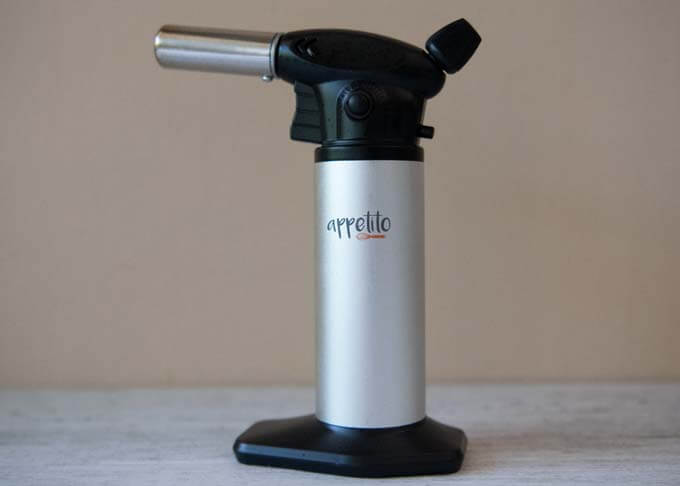
How to Make Salmon Nigiri
In my post Temakizushi, I explained how to make shari (vinegar rice), so in this section, I will concentrate on slicing the salmon fillet and making nigiri sushi.
How to slice salmon for nigiri sushi
As a rule, you need to slice a fillet against the grain of the flesh so that the slices are tender. This rule applies to other raw fish too. For salmon, you can use the white fat lines as a guide.
-
- If your fillet is very large, cut it in half so that the width of the fillet is close to or slightly shorter than 8cm / 3⅛”. The white fat lines should be running perpendicular or diagonal to the width.
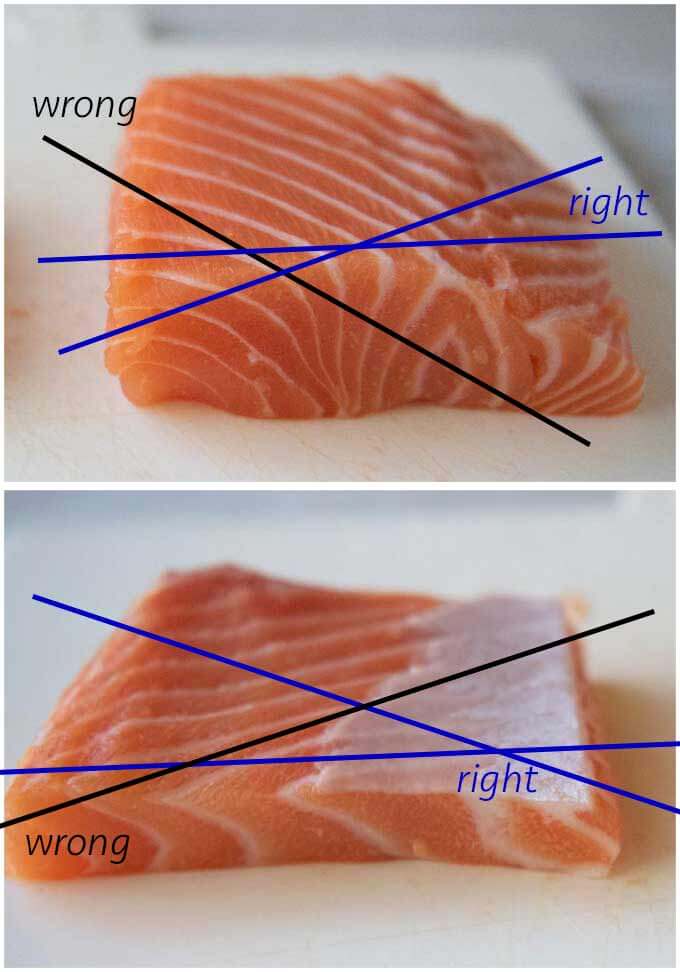
- Using the sogi-giri method (slant cutting), trim off the left top edge (for the right hander) of the fillet diagonally by tilting the knife at an angle, so that the cut area becomes about 3cm x 8cm / 1¼” x 3⅛”. If the width of the filet is narrower than 8cm / 3⅛”, place the blade diagonally on the fillet to get the wider length of the slice.
- Place the blade 3-5mm / ⅛-3⁄16″ from the left edge and slice the fillet diagonally parallel to the first slice.
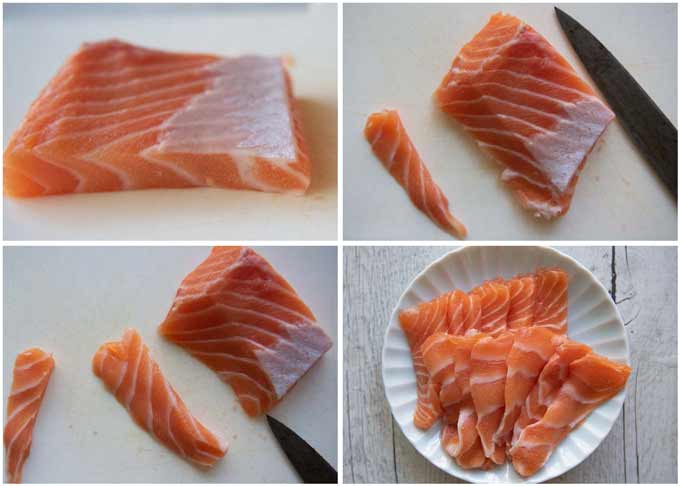
- If your fillet is very large, cut it in half so that the width of the fillet is close to or slightly shorter than 8cm / 3⅛”. The white fat lines should be running perpendicular or diagonal to the width.
Try to slice the fillet with one long movement of the knife. Place the blade closer to the handle on the fillet and move the knife towards you in one go. This prevents the soft salmon flesh from breaking. You should not slice the fillet by moving the knife back and forth.
How to make nigiri sushi
- Wet both palms in tezu, then remove excess liquid from hands.
- Take 15g/ 0.5oz of shari on your right hand (for the right hander), gently squeeze your hand and make a tiny rice ball.
- Place a piece of salmon on your left hand, then place the rice ball in the centre of the salmon.
- Press the rice to make a dent (to give air to the rice), then turn it over.
- Squeeze the left hand while pressing the right index finger on the salmon to shape.
A detailed explanation of how to shape a nigiri sushi is in the recipe card. Here is the step-by-step photo of how to make salmon nigiri sushi.
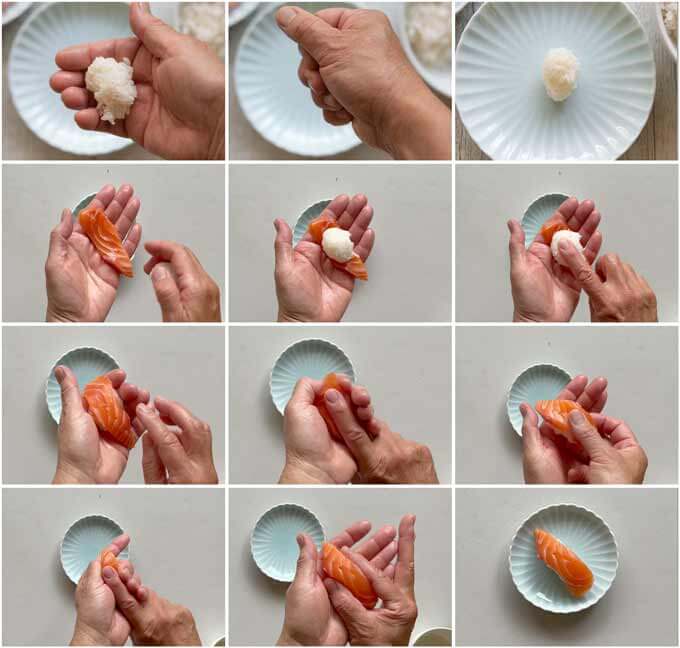
The idea in step 5 above is to make the rice firm (but not hard) and shape it into a round rectangle shape, while covering the top and the side of the rice with the salmon.
There is no single method of shaping nigiri sushi. Each sushi chef has his/her accustomed way of making nigiri. The above method is the best for me but you might prefer different methods.
I didn’t use wasabi today because I brushed the seared salmon with sweet tare, but if you are not using tare, place a small amount of wasabi paste on the salmon piece before placing a rice ball on it. You need to dip the nigiri in soy sauce to eat it in this case.
How to Make Aburi Salmon
- Place salmon nigiri pieces together on a heat resistant plate or a metal tray.
- Blowtorch the surface of the salmon pieces until the surface begins to char a bit. Ensure that you sear the entire surface of the salmon pieces and do not burn the rice.
- Garnish with few slices of red onion and a tiny sprig of curly parsley on each salmon nigiri, if using.
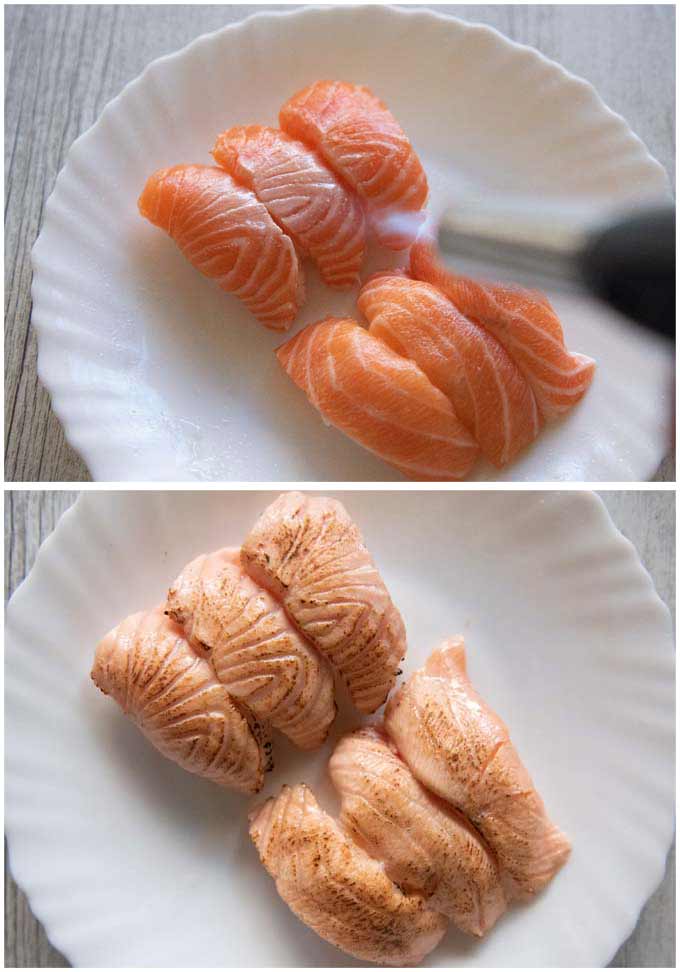
Not every household has a blowtorch. If you don’t have a blowtorch, you can make Aburi Salmon in one of the following few ways:
- Put thin metal skewers through the fillet and burn the surface of the fillet over the gas cooktop. Then slice the fillet suitable for nigiri sushi. This is the same method as searing bonito fillet to make Bonito Tataki (Seared Bonito). In this method, the surface of the salmon on the sushi rice shows raw flesh but the edge around the piece is seared.

- Instead of searing a salmon fillet directly over the flame, you can sear it on a frying pan. Then slice it into the pieces suitable for nigiri sushi.
- Scrunch a large piece of aluminium foil, then spread it on a baking tray. Place salmon pieces on the scrunched foil and place the tray under the broiler/oven griller, very close to the heat. Do not cook too long otherwise the entire piece gets cooked through instead of leaving part raw.
Here are the two different kinds of Seared Salmon Nigiri with a couple of salmon ‘gunkan maki’ (軍艦巻き, boat-shaped sushi).
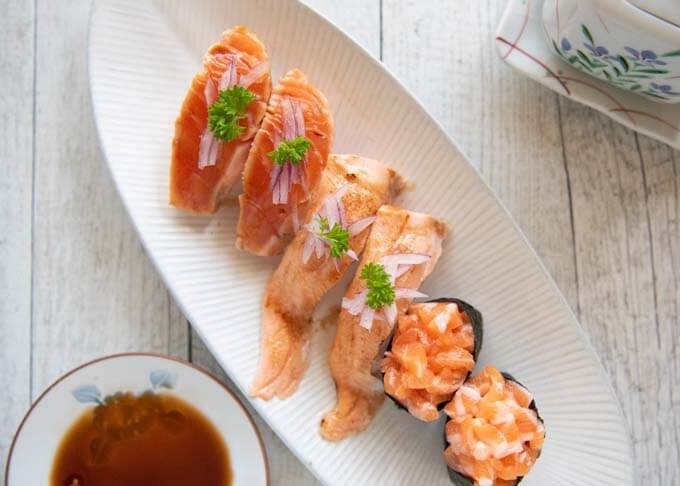
From top left: Seared the fillet first, then sliced Aburi Salmon x 2, Blowtorch Aburi Salmon x 2, Gunkan salmon x 2
It is OK if your sushi does not look like the ones made by professionals. Even if your salmon is a bit smaller or thicker, don’t worry about it. Regardless of the look, they taste great.
Yumiko![]()
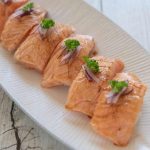
Seared Salmon Nigiri (Aburi Salmon) is very popular among Aussies, particularly with a sweet soy-based sauce brushed over the seared salmon. By searing it, the salmon becomes sweeter and more delicious. You will end up eating so many pieces without realising it.
Cook Time does not include the time to cook rice.
Don't forget to see the section 'MEAL IDEAS' below the recipe card! It gives you a list of dishes that I have already posted and this recipe that can make up a complete meal. I hope it is of help to you.
- 180-200g / 6.3-7.1oz salmon fillet , skinless (note 1)
- 180g / 6.3oz hot cooked rice (note 2)
- 2 tbsp rice wine vinegar
- 2 tbsp water
- 15ml / 0.5oz rice wine vinegar
- 1 tsp sugar
- ⅛ tsp salt
- 2 tbsp finely sliced red onion (about 3cm / 1¼" long)
- Sprigs of curly parsley
-
Put all the Tare ingredients in a small saucepan and bring it to a boil. Bring the heat down and simmer gently until the liquid reduces to about half of the original quantity.
-
Put the Sushi Rice Vinegar ingredients in a bowl and mix well until the sugar is dissolved.
-
Sprinkle the Sushi Rice Vinegar over the hot rice in a bowl and mix using a spatula. Move the spatula in a cutting motion so that you don’t break the rice grains. Cover the bowl with a wet kitchen towel/kitchen paper.
-
Slice the salmon fillets into 3-5mm / ⅛-3⁄16" thick pieces using the sogi-giri (slant cutting) method. Each slice should be about 3cm / 1¼" wide, 8cm / 3⅛" long (note 4).
-
Mix the Tezu ingredients in a small bowl.
-
Wet both palms with the tezu, massage hands ensuring that all fingers including between the fingers are wet (note 5). Then clap your hands once so that the excess liquid will be splashed and eliminated.
-
Take 1/12 of the rice (about 15g / 0.5oz) in your right hand and squeeze the rice gently to make a ball (about 3-3.5cm / 1¼-1⅜" in diameter).
-
Place a salmon piece across the proximal phalanx (base section of the fingers) of your left hand (for the right hander).
-
Place the rice ball on the centre of the salmon piece, then make a dent in the centre of the rice with your right index finger (to air the rice).
-
Turn the sushi over by rolling it towards the tips of your fingers and move it to where the salmon piece was placed initially.
-
Place your right index finger on the salmon, place the left thumb on the edge of the rice and squeeze the left hand gently while pressing the index finger slightly (to firm up the entire sushi piece).
-
Turn it around 180 degrees and do the same so that the shape of the sushi becomes a rounded rectangle.
-
With your right thumb and the index finger, hold the sides of the sushi including the edge of the salmon piece, and squeeze very gently (to shape and wrap the sushi with the salmon).
-
Repeat for the remaining salmon pieces.
-
Place the salmon nigiri pieces on a heat resistant plate or a tray. Using a blowtorch, sear the surface of the salmon until it begins to lightly char.
-
Brush the tare over the salmon a couple of times, then place a small amount of sliced red onion topped with a tiny sprig of parsley if using.
1. The mid-body portion of the fillet is easier to slice if you are not used to making sashimi slices out of it. The belly portion of the fillet is trickier to slice but it is richer in flavour.
2. For sushi, you need to use either short grain rice (standard Japanese rice) or the rice sold as 'sushi rice' as the grains stick together better.
3. Most sushi shops in Japan do not use tare on Aburi Salmon. They serve Aburi Salmon expecting the diners to dip it in soy sauce, just like other raw fish nigiri sushi.
But in Australia, it is common to get Aburi Salmon sushi with sweet soy-flavoured tare brushed on it.
If you want to serve salmon nigiri without tare, I'd suggest that you put a small amount of wasabi paste on the salmon piece before putting the rice on.
4. If your fillet is large, cut it in half so that the width of the fillet is close to or slightly shorter than 8cm / 3⅛". The white fat lines should be running perpendicular or diagonal to the width.
Sogi-giri allows you to slice a fillet into the required size and thickness more easily than the standard slicing method. Because of the way you place the blade at an angle, you can control the width, length, and the thickness of the slice better (see the step-by-step photo in the post).
5. This is to prevent the rice from sticking to your hands. Hands should be wet but not too wet. If excessively wet, brush your hands with a towel to remove excess liquid.
6.

7. Nutrition per piece.
serving: 38g calories: 64kcal fat: 2.1g (3%) saturated fat: 0.5g (2%) trans fat: 0.0g polyunsaturated fat: 0.6g monounsaturated fat: 0.6g cholesterol: 8.3mg (3%) sodium: 179mg (7%) potassium: 72mg (2%) carbohydrates: 6.9g (2%) dietary fibre: 0.1g (0%) sugar: 2.5g protein: 3.7g vitamin a: 1% vitamin c: 1% calcium: 0.3% iron: 1.5%
Meal Ideas
A typical Japanese meal consists of a main dish, a couple of side dishes, a soup and rice. I try to come up with a combination of dishes with a variety of flavours, colours, textures and make-ahead dishes.
The list below contains the similar dishes found on the menus of the traditional sushi restaurants, or the dish that sushi restaurants serve as an appetiser called ‘otōshi’ (お通し). I talked about otōshi in my post Izakaya-style Marinated Quail Eggs.
Naturally, most dishes are seafood-based, except for Dashimaki Tamago. Dashimaki Tamago is one of the nigiri pieces in the standard set of nigiri sushi and people often request for a thick slice of Dashimaki Tamago as a side dish.
- Main: Seared Salmon Nigiri (Aburi Salmon) – today’s recipe
- Side dish 1: Seafood Nuta (Miso Dressing) Two Ways – either dish of these Seafood Nuta can work well
- Side dish 2: Dashimaki Tamago (Japanese Rolled Omelette) – make ahead
- Salad: Crab and Cucumber Salad with Sweet Vinegar Dressing (Amazu) – or Cucumber and Seaweed Sunomono (Vinegar Dressing)
- Soup: Clear Soup with Clam – or miso soup of your choice
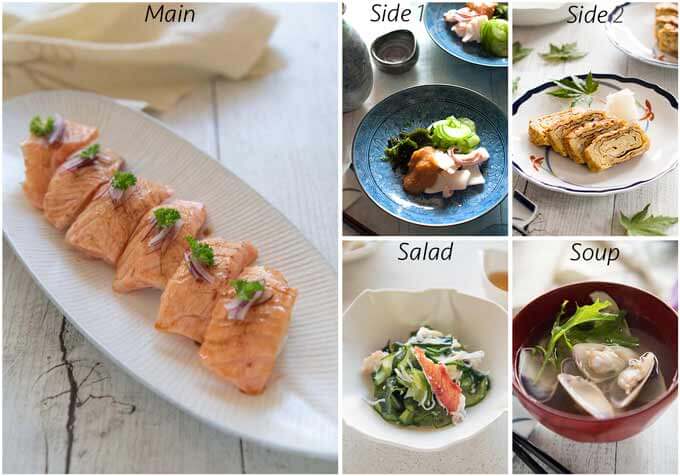
Thanks for your recipe, I will give this a try! If I sear the salmon till is pretty much cooked can I get away with using supermarket bought salmon? I know the quality and flavour won’t be as amazing, more concerned about food safety.
Hi Mary, you may want to sear the salmon pieces before putting them on the rice if you want to use the salmon that is not for sashimi. The texture of the salmon will be different, but you can enjoy the good flavour from the sauce.
If you like it, you may want to get a small amount of sashimi and see the difference.
Apologies for my late rating.
I made it and I can say this recipe is amazing! I used to be able to find shashimi grade salmon, but not anymore here in Auburn. Not sure if the fish market would sell it. I used to buy it from the sushi shop.
Regardless. Thank you for your so well explaoined recipe Yumiko, your are very thorough! I follow your website and I have tried some of your recipes. Glad you published a oven baked katsu :):):):)
I was wondering if I could ask for advice about what kind of fish is good for steam? I’m trying to change my eating habits into a better ones 🙂
Kindest Regards,
Maria
Hi Maria, I am glad to know that you enjoyed Aburi Salmon. Sydney Fish Market sells all kind of sashimi.
As for steaming fish, although white flesh fish is most popular for steaming, almost any kind of fish can be steamed. If you are using a fish fillet, you need to keep the skin on. If your fish is oily and/or the flesh is not white, you may want to add an extra cooking sake over it to remove fishness. If you can have alcohol, Sakamushi is one of the easiest and great way of eating steamed fish.
This was so so good although I definitely need to improve my salmon slicing. The sauce was so nice over everything too. So simple and delicious.
Hi Leah, if you get a thick fillet and use a sharp knife, you don’t need to do sogi-giri, which is a bit more difficult. Use a knife with long blade so that you have more chance of slicing the fillet in one motion.
Is “Sashimi quality fish fillet” literally how the fish is marked? I’ve long been interested in trying to make raw fish dishes, but haven’t because sourcing the correct quality of fish seemed confusing and I didn’t want to mess up (and get sick).
Hi Brian, in Australia where I live, fish shops do label fillets with the word ‘sashimi’ or ‘sushi’ if they are fresh and good to be eaten raw. I am not sure in other counties but I found the article on sashimi quality fish by a culinary consultant who lives in the USA. This article might help.
Thank you so much for the very detailed recipe. I asked for this recipe some time ago as my little daughter likes it so much. Very much appreciated.
Hi Ana, sorry for taking so long to post this. I hope you can enjoy making nigiri.
These step by step photos are immensely helpful! I was so unhappy with my results last time I tried to make nigiri sushi, I said I wouldn’t try it again. Time to give it another go. 👍👍
Hi Sara, it is definitely worth giving it once more. Good luck!